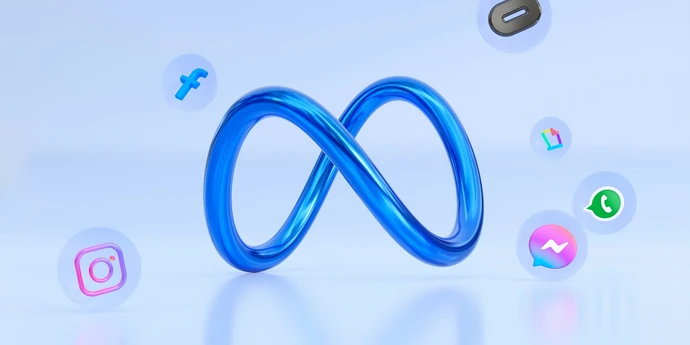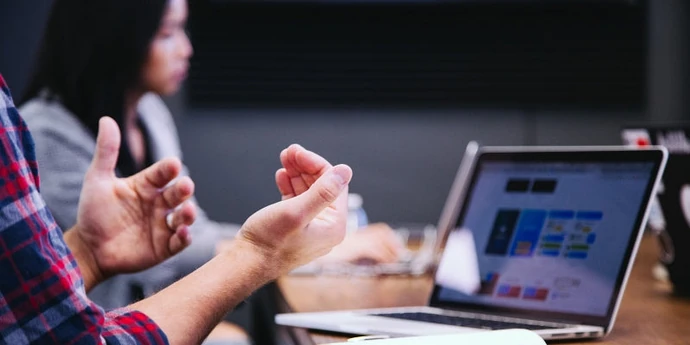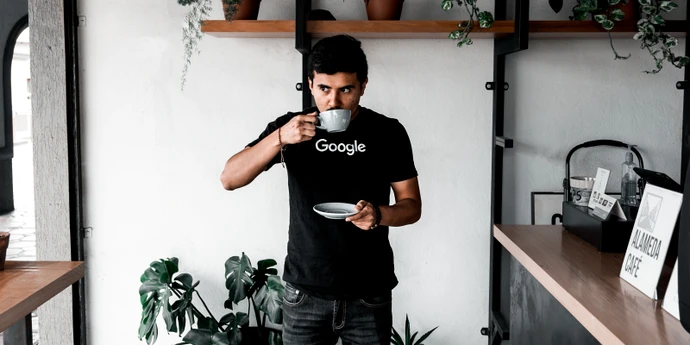Microsoft software engineer interviews are tough to crack. The questions are difficult, specific to Microsoft, and cover a wide range of topics.
The good news is that the right preparation can make a big difference. We've analyzed over 250 software engineer interview questions reported by Microsoft candidates, categorized them, and listed a selection.
Below, you’ll find a detailed breakdown of the interview process, preparation tips, and links to the best resources, so that you can prepare more strategically and maximize your chances of landing that software engineer job at Microsoft.
Here's an overview of what we will cover:
Click here to practice 1-on-1 with a Microsoft SWE ex-interviewer
Let's get started!
1. Microsoft software engineer role and salary ↑
Before we cover your Microsoft software engineer interviews, let’s first look at the role itself.
1.1 What does a Microsoft software engineer do?
At Microsoft, a software engineer’s role depends on both their level and the team they work with.
Note that Microsoft’s career ladder follows a unique structure, with multiple levels assigned to the same role title. The differences between adjacent levels (e.g., 59 vs. 60) usually reflect the scope of impact, autonomy, and performance maturity of the candidate.
Here’s a breakdown of the individual contributor (IC) track for software engineers at Microsoft:
- 59 & 60: Software Engineer (entry-level)
- 61 & 62: Software Engineer II (mid-level)
- 63 & 64: Senior Software Engineer
- 65, 66 & 67: Principal Software Engineer
- 68 and above: Partner, Distinguished Engineer, and Technical Fellow
Our analysis of Microsoft job listings shows that early-career software engineers are typically focused on building foundational skills while contributing to team projects. Their core responsibilities often include:
- Collaborating with teammates to design and implement services and data pipelines
- Writing clean, maintainable, and well-tested code
- Using scripting languages like Python or PowerShell to automate tasks, often with guidance from more senior engineers
As you gain seniority, you’ll start to take on more complex problems, begin owning core services, lead small projects, and mentor junior engineers.
What skills are required to be a Microsoft Software Engineer?
The minimum requirements for a Microsoft software engineering role typically include a bachelor’s or master’s degree in Computer Science or a related technical field. Some roles may also accept equivalent practical experience.
Candidates are expected to have proficiency in one or more programming languages, such as C, C++, C#, Java, JavaScript, or Python, as well as experience with scripting languages like Python, PowerShell, or JavaScript.
Some roles, particularly those involving large-scale systems or cloud infrastructure, may require 2+ years of experience building and operating production services.
In addition to technical skills, Microsoft places a strong emphasis on design and analytical thinking, as well as effective communication and collaboration.
1.2 How much does a Microsoft software engineer make?
Based on Glassdoor data, the average total pay for a Microsoft software engineer is $218,000 per year, which is 10% higher than the estimated average total for a software engineer at other companies.
Below you can see the average salary and compensation of the different software engineer levels at Microsoft US, as of July 2025, based on Levels.fyi.
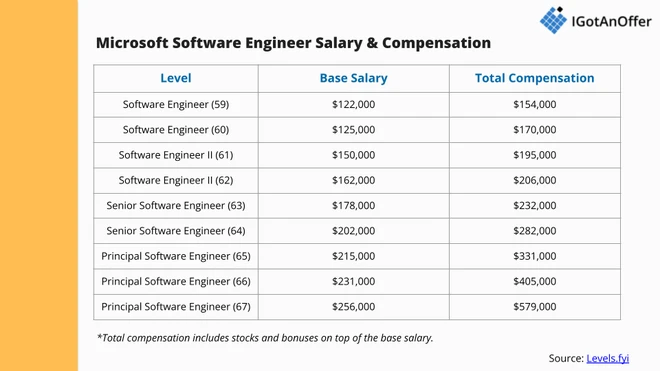
The average salary of Microsoft software engineers also varies depending on location and cost of living. For example, a Level 62 Microsoft software engineer in the U.S. typically earns significantly more than a Level 62 software engineer based in India.
While we presume that you already know which specific level you are applying for, it’s still good to double-check this with your recruiter. Your recruiter should be able to advise you on which level you’re being evaluated.
Ultimately, how you do in your interviews will help determine what you’ll be offered. That’s why hiring one of our ex-Microsoft interview coaches can provide such a significant return on investment.
And remember, compensation packages are always negotiable, even at Microsoft. So, if you do get an offer, don’t be afraid to ask for more. If you need help negotiating, consider booking one of our salary negotiation coaches to get expert advice.
2. Microsoft software engineer interview process and timeline ↑
2.1 What interviews to expect
What's the Microsoft software engineer interview process and timeline? It takes four to eight weeks on average and follows these steps:
- Resume screen
- Recruiter phone screen (45 minutes)
- Initial screen: online test, technical phone screen, or on-campus
- Onsite interviews (4-5 interviews x 1 hr each)
As a side note, Microsoft’s interview process has some similarities with software engineer interviews at LinkedIn (which is a Microsoft subsidiary).
If you're interviewing for a management role, take a look at our Microsoft engineering manager interview guide.
2.1.1 Resume screen
First, recruiters will look at your resume and assess if your experience matches the open position. This is the most competitive step in the process, as millions of candidates do not make it past this stage.
To stand out, you’ll need to have an outstanding resume. Take a look at real software engineer resume examples to see which kinds of resumes get noticed and how you can make yours stand out, too.
If you’re looking for expert feedback, get input from our team of ex-FAANG recruiters, who will cover what achievements to focus on (or ignore), how to fine-tune your bullet points, and more.
Getting an employee referral might also help. According to Glassdoor, 13% of candidates who got interviews with Microsoft had employee referrals.
2.1.2 Recruiter screen
Next, the interview process starts with a 45-minute HR recruiter call to discuss your interests and to see which group or team would be best for you.
Your recruiter will also use this conversation to confirm that you've got a chance of getting the job at all. You should be prepared to explain your background and why you’re a good fit for Microsoft.
2.1.3 Initial screen
If things go well with the recruiter, then you'll move on to the next step of the process. What happens at this stage varies depending on what team and role you're applying for.
You can usually expect a technical phone screen if you're an industry hire, an on-campus interview if you're a new graduate, or an online coding assessment instead of an actual interview in some cases. We'll review each format below.
Technical phone screens
This step is called the "phone screen", but it can also sometimes happen over video using Microsoft Teams. Each interview will last 45 to 60 minutes. You'll speak to a peer or a potential manager, and they'll ask you a mix of technical and behavioral questions.
For the technical part of the interview, you can expect typical data structure and algorithm questions, which you'll have to solve in an online collaborative text editor.
The text editor won't have syntax highlighting or autocomplete features, so you'll need to get used to not having those features during your interview preparation. As an additional note, you're very unlikely to be asked system design questions during your phone screen.
For the behavioral part, you can expect questions like, "Tell me about yourself," "Why Microsoft?" or "What's your favorite Microsoft product and why?".
In our experience, Microsoft interviewers spend more time on behavioral questions than their counterparts at Meta or Google. So, it's worth making sure you're ready for common behavioral questions (more on that later).
On-campus interview
If you're a student, then you'll usually have an on-campus interview instead of a phone screen. You'll be asked a mix of behavioral questions and coding questions that you'll need to solve on a whiteboard.
Some candidates report having multiple interviews on campus, and in some cases, a mix of online and in-person formats.
Online coding assessment
Microsoft may give you an online coding test before inviting you to onsite interviews. The most common is a three-question test on Codility, which you’ll have 60 to 90 minutes to complete.
The questions are typical data structure and algorithm questions for which you need to submit a solution in an online editor. Leetcode maintains a helpful thread of the types of questions that have recently been asked in the test.
2.1.4 Onsite interviews
If you pass the first round, the next step involves four to five onsite interviews. These used to take place on-site at a Microsoft office, but as of now, the process is held virtually on Microsoft Teams.
These interviews will last about 60 minutes and be a one-on-one with a mix of people from the team you’re applying to join, including peers, the hiring manager, and sometimes a senior executive.
Three or four of your interviews will include coding questions (i.e., data structure and algorithm questions), which you'll need to solve on a third-party tool like CoderPad. The other one or two interviews will cover system design questions. You'll be asked behavioral questions in all your interviews.
All candidates are expected to do extremely well in coding and behavioral questions. If you're relatively junior (e.g. Level 59 & 60) you might not be asked system design questions. And if you do, then the bar will be lower than for mid-level or senior engineers (e.g., Level 61 or above).
The "as appropriate," AA, or ASAPP interview (optional)
Finally, your last onsite interview will be with a senior executive from Microsoft (e.g., your hiring manager or possibly their boss). This interview is often referred to as the "as appropriate", AA or ASAPP interview, because you will only be asked to do that interview if your first three interviews go well.
If you don't do well in the first three, then you won't get an AA interview, and you won't get an offer.
AA interviewers have two roles. The first one is to ensure that there's no blind spot in your assessment. For instance, if your first three interviewers have established that you meet the technical hiring standards but aren't sure about culture fit, then your AA interview will mainly focus on behavioral questions.
The second role of an AA interviewer is to "sell" the company to you if you did well in previous interviews. The idea here is that Microsoft wants to make sure you'll accept the offer if they decide to make you one.
2.2 What exactly Microsoft is looking for
At the end of each interview, your interviewer will grade your performance using a standardized feedback form. Here is some of the information that's contained in the form.
A) Interview notes
Interviewers will file the notes they took during the interview. This usually includes: the questions they asked, a summary of your answers, and any additional impressions they had (e.g., communicated ABC well, weak knowledge of XYZ, etc).
B) Competencies assessment
Your interviewer will then grade you on different competencies. They will be trying to determine if you meet the bar or not for each competency they are interested in. In other words, you'll need to convince them that you are at least as good as, or better than, the average current Microsoft SDE at the level you're applying for (e.g., Senior SDE).
The exact list of competencies Microsoft looks for varies depending on groups, roles, and levels. But here are some of the main ones that are usually discussed by Microsoft recruiters:
- Passion for technology
- Problem solving
- Analytical ability
- Creativity
C) Hiring recommendation
Each interviewer will give a hiring recommendation at the end of the interview. The different options are along the lines of: "Strong hire", "Hire", "No hire", "Strong no hire".
D) Suggested follow-ups
The feedback forms are accessible to all the interviewers in your loop. And each interviewer can suggest a follow-up topic for your next interview. For instance, if you didn't check edge cases in your first coding question, then your interviewer might flag that with you and also with your next interviewer, so they can see if you will apply the feedback.
2.3 What happens behind the scenes
Your recruiter is leading the process and taking you from one stage to the next. Here's what happens at each of the stages described above:
- After the first round, your recruiter and hiring manager decide whether to move you to the onsite interviews or not, depending on how well you've done.
- After the onsite, each interviewer files their notes into the internal system, grades you, and makes a hiring recommendation (e.g., "Strong hire", "Hire", "No hire", "Strong no hire"). You usually need to receive a "Hire" grade from all interviewers to get an offer. But in some cases, the AA interviewer and/or hiring manager can decide to hire you even if you got one "No hire".
- You get an offer. If everything goes well, the recruiter will be in touch with an offer, usually within a week of the onsite, but it can sometimes take longer
It's also important to note that recruiters and people who refer you have little influence on the overall process. They can help you get an interview at the beginning, but that's about it.
3. Example questions ↑
Here at IGotAnOffer, we believe in data-driven interview preparation and have used Glassdoor data to identify the types of questions that are most frequently asked at Microsoft.
For coding interviews, we've broken down the questions you'll be asked by subcategories (e.g., Arrays / Strings, Graphs / Trees, etc.) so that you can prioritize what to study and practice first.
For system design and behavioral questions, we've listed questions that were frequently reported on Glassdoor and other resources.
3.1 Coding questions ↑
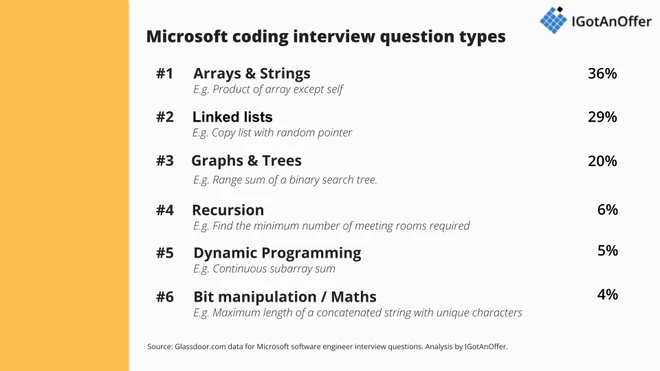
Microsoft software development engineers solve some of the most difficult problems the company faces with code. It's therefore essential that they have strong problem-solving skills. This is the part of the interview where you want to show that you think in a structured way and write code that's accurate, bug-free, and fast.
You will be asked to code only in the language you’re most comfortable in. Microsoft uses a third-party coding tool in its interviews, where you can run and compile your code.
Here are the most common question types asked in Microsoft coding interviews and their frequency.
- Arrays / Strings (36% of questions, most frequent)
- Linked lists (29%)
- Graphs / Trees (20%)
- Search / Sort (6%)
- Dynamic programming (5%)
- Bit manipulation / Maths (4% of questions, least frequent)
Below, we've listed common examples used at Microsoft for each of these different question types. To make these questions easier to study, we've modified the phrasing to match the closest problem on Leetcode or another resource, and we've linked to a free solution.
Example coding questions asked in Microsoft software engineer interviews
1. Arrays / Strings (36% of questions, most frequent)
- "Given an input string, reverse the string word by word." (Solution)
- "Given an array of integers nums and an integer target, return indices of the two numbers such that they add up to target. You may assume that each input would have exactly one solution, and you may not use the same element twice." (Solution)
- "Given a 2D board and a word, find if the word exists in the grid. The word can be constructed from letters of sequentially adjacent cell, where "adjacent" cells are those horizontally or vertically neighboring. The same letter cell may not be used more than once." (Solution)
- "Given an unsorted integer array, find the smallest missing positive integer...Your algorithm should run in O(n) time and uses constant extra space." (Solution)
- "Given a C++ program, remove comments from it. The program
sourceis an array wheresource[i]is thei-th line of the source code. This represents the result of splitting the original source code string by the newline character\n." (Solution) - "Given a matrix of m x n elements (m rows, n columns), return all elements of the matrix in spiral order." (Solution)
- "Given an array of characters chars, compress it using the following algorithm: Begin with an empty string s. For each group of consecutive repeating characters in chars: If the group's length is 1, append the character to s. Otherwise, append the character followed by the group's length. The compressed string s should not be returned separately, but instead be stored in the input character array chars. Note that group lengths that are 10 or longer will be split into multiple characters in chars. After you are done modifying the input array, return the new length of the array." (Solution)
- "Given a string, find the length of the longest substring T that contains at most k distinct characters." (Solution)
Check out our guides on array interview questions and string interview questions to learn more about the topics.
- "Given a linked list, reverse the nodes of a linked list k at a time and return its modified list. k is a positive integer and is less than or equal to the length of the linked list. If the number of nodes is not a multiple of k then left-out nodes in the end should remain as it is." (Solution)
- "A linked list is given such that each node contains an additional random pointer which could point to any node in the list or null. Return a deep copy of the list." (Solution)
- "You are given an array of k linked-lists lists, each linked-list is sorted in ascending order. Merge all the linked-lists into one sorted linked-list and return it." (Solution)
- "Given a linked list, swap every two adjacent nodes and return its head. You may not modify the values in the list's nodes, only the nodes themselves may be changed." (Solution)
- "Given the head of a linked list, return the list after sorting it in ascending order. Follow up: Can you sort the linked list in O(n logn) time and O(1) memory (i.e., constant space)?" (Solution)
Check out our guide on linked list interview questions to learn more about the topic.
- "Given preorder and inorder traversal of a tree, construct the binary tree. Note: You may assume that duplicates do not exist in the tree." (Solution)
- "Serialize and deserialize N-ary tree" (Solution)
- "Given a node in a binary search tree, find the in-order successor of that node in the BST." (Solution)
- "Given a binary tree, determine if it is a valid binary search tree (BST)." (Solution)
- "Given a root node reference of a BST and a key, delete the node with the given key in the BST. Return the root node reference (possibly updated) of the BST. Basically, the deletion can be divided into two stages: 1) Search for a node to remove. 2) If the node is found, delete the node. Follow up: can you solve it with time complexity O(height of tree)?" (Solution)
- "Given a directed, acyclic graph of
Nnodes. Find all possible paths from node0to nodeN-1, and return them in any order. The graph is given as follows: the nodes are 0, 1, ..., graph.length - 1. graph[i] is a list of all nodes j for which the edge (i, j) exists." (Solution)
Click here to learn more about graph interview questions and tree interview questions.
- "Given a 2d grid map of
'1's (land) and'0's (water), count the number of islands. An island is surrounded by water and is formed by connecting adjacent lands horizontally or vertically. You may assume all four edges of the grid are all surrounded by water." (Solution) - "You are given a perfect binary tree where all leaves are on the same level, and every parent has two children...Populate each next pointer to point to its next right node. If there is no next right node, the next pointer should be set to
NULL. Initially, all next pointers are set toNULL." (Solution) - "Given two sorted arrays nums1 and nums2 of size m and n respectively, return the median of the two sorted arrays." (Solution)
-
"Write an efficient algorithm that searches for a value in an m x n matrix. This matrix has the following properties: [1] Integers in each row are sorted from left to right. [2] The first integer of each row is greater than the last integer of the previous row." (Solution)
Check out our guides on search interview questions and sort interview questions to learn more about the topics.
- "Given an integer array
nums, find the contiguous subarray (containing at least one number) which has the largest sum and return its sum." (Solution) - "Given n non-negative integers representing an elevation map where the width of each bar is 1, compute how much water it is able to trap after raining." (Solution)
- "Given an input string (
s) and a pattern (p), implement regular expression matching with support for'.'and'*'...The matching should cover the entire input string (not partial)." (Solution)
Check out our guide on dynamic programming interview questions to learn more about the topic.
6. Bit manipulation / Maths (4% of questions, least frequent)
Finally, we recommend reading this guide on how to prepare for a coding interview and practicing with this list of coding interview examples in addition to those listed above.
3.2 System design questions ↑
Microsoft products have millions of monthly active users. Therefore, the company's engineers need to be able to design scalable systems.
The coding questions we've covered above usually have a single optimal solution. But the system design questions you'll be asked are typically more open-ended and feel more like a discussion.
This is the part of the interview where you want to show that you can both be creative and structured. In most cases, your interviewer will adapt the question to your background.
For instance, if you've worked on an API product, they'll ask you to design an API. But that won't always be the case, so you should be ready to design any type of product or system at a high level.
As mentioned previously, if you're a junior engineer, the expectations will be lower for you than if you're mid-level or senior. In addition, for certain roles (e.g. infrastructure, security, etc.), you will likely have several system design interviews instead of just one.
Below we've listed some common system design questions that can be found in the Microsoft interview reports on Glassdoor or relevant forums (like the Leetcode forum).
Example system design questions asked at Microsoft software engineer interviews
- Design an IDE like Visual Studio.
- Design Instagram.
- Design Uber.
- Design OpenTable.
- Design Dropbox / iCloud.
- Design a shopping cart for Amazon.com.
- Design the photo gallery app on iOS.
- Design a distributed cache.
- Design an API for a running app.
- Design an API for a tic-tac-toe game.
- Design a scalable system for Uber Eats.
- Design a library system that has both online and offline customers.
- Design a social media platform from the ground up.
- Design a feature for Microsoft Teams targeting university students in Japan.
- Design a scalable microservice for handling high-volume real-time transactions, including API structure, data storage, and fault tolerance.
- Design a website to handle world-scale traffic.
- Design a notification system along with its edge cases.
- Design a search engine.
For more information, we recommend reading our guide on how to answer system design questions and practicing with our system design interview questions and prep guide.
3.3 Behavioral questions ↑
Lastly, expect behavioral and resume questions to assess your motivation and cultural fit. Many candidates fail a Microsoft interview due to a lack of preparation, but these questions are easy to tackle if you know what to expect.
Interviewers at Microsoft also place strong emphasis on your reasons for choosing the company. Be ready to answer questions like “Why Microsoft?” and “What’s your favorite Microsoft product? And why?”
It's worth noting that Microsoft has spent the past decade shifting its culture to embrace a growth mindset. Showing that you embrace challenges, are willing to experiment, and see failure as a path to learning and innovation are all good ways to show you're a good fit for the company.
Example behavioral questions asked at Microsoft software engineer interviews
- Tell me about yourself.
- Why Microsoft? (See sample answer from Amazon interviews.)
- What's your favorite Microsoft product? And why?
- Why are you / do you want to be a software engineer?
- What do you think are the three qualities necessary to work at Microsoft?
- Tell me about a recent / favorite project and some of the difficulties you faced.
- Tell me about the greatest accomplishment / failure of your career.
- Tell me about a time you struggled to work with one of your colleagues.
- Tell me about a time you led a team.
- Tell me about some of the biggest lessons you've learned in life.
- Tell me about your values and the kind of environments you thrive in.
To read example answers to typical behavioral questions for SWEs, see our guide to the most-asked behavioral questions at tech companies.
4. Microsoft software engineer interviewing tips ↑
You might be a fantastic software engineer, but unfortunately, that won’t be enough to ace your interviews at Microsoft. Interviewing is a skill in itself that you need to learn.
Let’s look at some key tips to make sure you approach your interviews in the right way.
4.1 Ask clarifying questions
Often, the questions you’ll be asked will be ambiguous, so make sure you ask questions that can help you clarify and understand the problem.
4.2 Think out loud
You need to walk your interviewer through your thought process before you actually start coding or designing a system. Microsoft recommends that you share your thought process and explain the rationale behind your decisions.
Your interviewer may give you hints about whether you’re on the right track or not. This shows you’re eager to learn and listen well to feedback
4.3 State and check assumptions
In your system design interview, you need to explicitly state assumptions and check with your interviewer to see if those assumptions are reasonable.
4.4 Break the problem into smaller tasks
The types of coding questions that are asked in tech interviews can typically be broken down into 2-5 tasks that will each take a few minutes to complete. While you’re making your plan, list out these small steps and explain them to your interviewer.
As you work, cross out each of these steps one by one, and tell your interviewer (e.g., “I have completed task X, and now I will work on Y, then Z.”). This will give you a confidence boost each time you finish a smaller task.
It will also give the interviewer a sense of your ability to tackle long-term, difficult projects on the job.
4.5 Present multiple possible solutions
When you code, present multiple possible solutions if you can. Microsoft wants to know your reasoning for choosing a certain solution.
4.6 Adapt to follow-up questions
Interviewers will ask follow-up questions, whether it’s a coding, system design, or behavioral interview. So don’t be alarmed if your interviewer asks them.
Listen carefully to the way your interviewer is asking these questions, as there will often be a subtle clue about what they’re looking to assess from the next part of your answer.
Some of the time, follow-up questions are a way for your interviewer to steer you in a particular direction. So don’t hesitate to follow them. In fact, listen actively for hints. 99% of interviewers have good intentions, and they're trying to help you.
4.7 Be honest and authentic
Be genuine in your responses. Microsoft interviewers appreciate authenticity and honesty. If you faced challenges or setbacks, discuss how you improved and learned from them.
5. Preparation plan ↑
Now that you know what questions to expect, let's focus on how to prepare. Here are the four most important things you can do to prepare for your Microsoft software development engineer interviews.
Applying for other companies too? Check out our other guides for Meta, Google, Amazon, LinkedIn, and Airbnb software engineer interviews.
5.1 Learn about Microsoft's culture
Most candidates fail to do this. But before investing tens of hours preparing for an interview at Microsoft, you should take some time to make sure it's actually the right company for you.
Microsoft is prestigious, and it's therefore tempting to ignore this step completely, but the prestige of the company, in itself, won't make you happy day-to-day. It's the type of work and the people you work with that will.
If you know engineers who work at Microsoft (or used to), talk to them to understand what the culture is like. In addition, we would also recommend reading the following resources:
- Microsoft's growth mindset culture (by Microsoft)
- How Microsoft’s growth mindset drives innovation (by i4cp)
- Microsoft strategy teardown (by CB Insights)
- Microsoft vision and mission analysis (by Panmore Institute)
- Microsoft’s culture and cultural traits (by Panmore Institute)
- Microsoft annual reports (by Microsoft)
5.2 Practice by yourself
As mentioned above, you'll have to answer three types of questions at Microsoft: coding, system design, and behavioral. The first step of your preparation should be to brush up on these different types of questions and to practice answering them by yourself.
5.2.1 Coding interview preparation
For coding interviews, we recommend getting comfortable with either of the two frameworks outlined below.
The first framework is a step-by-step approach recommended by Microsoft in the video below.
Here is a summary of the STAR approach recommended by Microsoft:
- Step 1: Situation, make sure you understand the problem correctly
- Write down the problem provided by the interviewer
- Ask clarification questions
- Agree on inputs and outputs
- Step 2: Task, outline how you are going to solve the problem
- Talk through your ideas for solving the problem out loud
- Start with a simple case and work toward a solution, without coding
- Think about different test cases which you'll use for testing later
- Step 3: Action, write clean code to solve the problem
- Start writing clean code with clear variable and function names
- Modularize your code with helper functions
- Check with your interviewer before using a library
- Bugs and forgotten variables are ok as long as you catch them early
- Step 4: Result, test your solution and suggest improvements
- Run through the different test cases you've developed in step 2
- Incorporate any feedback from the interviewer into your approach
- Analyze the time and space complexity of your code and suggest improvements
The second is a 5-step problem-solving approach from Amazon, which we covered in our coding interview prep article.
-
Step 1: Clarify
-
Ask clarification questions to remove ambiguity about the problem
-
Explore the edges of the problem
-
-
Step 2: Plan
-
Discuss potential approaches you could take
-
Pick an approach and lay out the high-level steps
-
-
Step 3: Implement
-
Write clean code, not pseudocode
-
Comment on your code as you go
-
-
Step 4: Test
-
Start by testing with a simple example
-
Try breaking your code with edge and corner cases
-
-
Step 5: Optimize
-
Calculate time complexity
-
Discuss how you can optimize your solution
-
5.2.2 System design interview preparation
For system design interviews, Microsoft does not give specific recommendations. But Amazon does, and the approach they outline in the video below is quite helpful.
Here is a summary of what you should do:
- Step 1: Ask clarification questions
- Understand the goal of the system (e.g., sell ebooks)
- Establish the scope of the exercise (e.g.. end-to-end experience, or just API?)
- Gather scale and performance requirements (e.g., 500 transactions per second)
- Talk through any assumptions you're making out loud
- Step 2: Design at a high level, then drill down
- Lay out the high-level components (e.g., front-end, web servers, database)
- Drill down and design each component (e.g,. front-end first)
- Start with the components you're most comfortable with (e.g,. front-end if you're a front-end engineer)
- Work with your interviewer to provide the right level of detail
- Step 3: Bring it all together
- Refer back to the requirements to make sure your approach meets them
- Discuss any tradeoffs in the decisions you've made
- Summarize how the system would work end-to-end
We'd also recommend studying our system design interview questions and prep guide and learning how to answer system design interview questions. These guides cover a step-by-step method for answering system design questions, and they provide several example questions with solutions.
5.2.3 Behavioral interview preparation
For behavioral interviews, we recommend learning our step-by-step method to answer this type of question and then practicing the most common software engineer behavioral interview questions.
In addition, you'll want to write down your answers to the common behavioral questions we have listed in the previous section.
Finally, a great way to practice coding, system design, and behavioral questions is to interview yourself out loud. This may sound strange, but it can significantly improve the way you communicate your answers during a real interview.
Play the role of both the candidate and the interviewer, asking questions and answering them, just like two people would in an interview.
However, by yourself, you can’t simulate thinking on your feet or the pressure of performing in front of a stranger. Plus, there are no unexpected follow-up questions and no feedback.
That’s why many candidates try to practice with friends or peers.
5.3 Practice with peers
If you have friends or peers who can do mock interviews with you, that's an option worth trying. It’s free, but be warned, you may come up against the following problems:
- It’s hard to know if the feedback you get is accurate
- They’re unlikely to have insider knowledge of interviews at your target company
- On peer platforms, people often waste your time by not showing up
For those reasons, many candidates skip peer mock interviews and go straight to mock interviews with an expert.
5.4 Practice with experienced SWE interviewers
In our experience, practicing real interviews with experts who can give you company-specific feedback makes a huge difference.
Find a Microsoft software engineer interview coach so you can:
- Test yourself under real interview conditions
- Get accurate feedback from a real expert
- Build your confidence
- Get company-specific insights
- Learn how to tell the right stories, better
- Save time by focusing your preparation
Landing a job at a big tech company often results in a $50,000 per year or more increase in total compensation. In our experience, three or four coaching sessions worth ~$500 make a significant difference in your ability to land the job. That’s an ROI of 100x!








